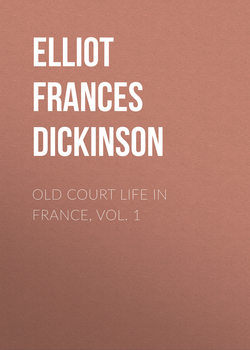Читать книгу Old Court Life in France, vol. 1 - Elliot Frances Minto Dickinson - Страница 14
CHAPTER IX.
CATHERINE DE’ MEDICI
ОглавлениеCATHERINE DE’ MEDICI, widow of Henry II., and mother of three kings regnant, rules France in their name. Her father, Lorenzo, Duke of Urbino, second tyrant of Florence, died before she was born; her mother, Madaleine de la Tour d’Auvergne (for Catherine had French blood in her veins), died when she was born; so fatal was this Medici, even at her birth.
The Duchessina, as Catherine was called, was reared by her aunt Clarice Sforza, within the mediæval stronghold of the Medici at Florence – now known as the Riccardi Palace. Although bereft of palisade and towers of defence, it is still a stately pile of Italian Gothic architecture, with pillared cortile, ornate front, and sculptured cornice, bidding a mute defiance to the encroachments of the modern buildings of the Via Cavour, the Corso of the City of Flowers.
Catherine was educated by the nuns of the “Murate” (walled up), in their convent near the Porta Santa Croce. The teaching of these lonely enthusiasts strangely contrasted with the life she afterwards led in the Florentine Court – a very hot-bed of vice, intrigue, and ambition. There did this Medea of the Cinque-cento learn how to dissimulate and to betray. At fifteen she became, by the favour of her uncle, Pope Clement VII., the richest heiress in Europe. She was tall and finely formed, of a clear olive complexion (inherited from her French mother), with well-cut features, and large, prominent eyes, like all the Medici. Her manners were gracious, her countenance expressive, but there was, even in extreme youth, a fixed and cold expression on the statuesque face that belied these pleasant attributes. Many suitors sought her hand, but Clement VII., outraged at the brutality of the Spanish coalition against him under Charles V., which had resulted in the sack of Rome and his own imprisonment in the Castle of St. Angelo, was glad to spite his enemies by bestowing his wealthy niece on the Duc d’Orléans, son of Francis I. As the heiress of the Medici came of a republican race of merchant princes, mere mushrooms beside the lofty antiquity of the Valois line, the Pope, to give greater lustre to the espousals, announced that he would himself conduct his niece to her future husband. At Leghorn, Catherine embarked with her uncle in a sumptuous papal galley, attended by his tonsured Court. A flotilla of boats accompanied the vice-regent of God upon earth, and his niece, the sparkling Duchessina. Fair winds and smooth seas soon wafted them to the French shore, where Francis and his sons awaited their arrival at Marseilles.
Francis, says Brantôme, was so charmed with the Medici bride, her intelligence and lively manners, that he romped with her the entire evening after her arrival. When Francis found that she danced admirably, that she shot with an arquebuse like a trooper, played at maille like a boy, and rode boldly and gracefully, his partiality to his new daughter-in-law knew no bounds. What was the opinion of the bridegroom Orléans, and what comparison he made between a bride of fifteen and a mistress of thirty-five, is not recorded. There was nearly twenty years difference in age between Prince Henry, Duc d’Orléans, a mere boy, and Diane de Poitiers, yet her influence over him was still absolute. To the day of his death he wore her colours – white and black – upon his shield. Diane, secure in power, was rather proud of her age. She boasted to the new Duchess that she was never ill, that she rose at six o’clock in the morning, bathed in the coldest water, and rode two hours before breakfast.
When Catherine first appeared at the Louvre as the bride of Prince Henry, she seemed but a clever, facile girl, ready to accept her humiliating position as subordinate in power, influence, and beauty to her husband’s mistress, Diane de Poitiers, as well as to the Duchesse d’Étampes, the favourite of Francis. Placed among these two women and the lonely Spanish Queen, Elinor of Portugal, for fourteen years she acquitted herself with the most perfect temper and discretion. Indeed, with strange self-command in one so young, she endeavoured to flatter both the favourites, but failing to propitiate either Diane or the Duchess, and not being able to attract her husband or to interest the sedate Spaniard, she devoted herself wholly to charm her father-in-law, Francis. She became the constant and beloved companion of his various progresses and hunting-parties to Fontainebleau, Amboise, Chenonceau, and Loches. No court pageants these, on ambling pads over smooth lawns, among limber trees, with retinue of velvet-liveried menials on the watch for any possible casualty; but hard and dangerous riding in search of boars, and wolves, and stags, over a rough country, among thick underwood, rocky hills, and precipitous uplands.
Thus Catherine seemed; but in her heart she despised the Duchess, abhorred Diane, and suffered all the mortification of a neglected wife. Diane did not moreover spare her feelings, but insolently and ostentatiously paraded her superior influence, especially after Prince Henry came to the throne and created her Duchesse de Valentinois.
Catherine, however, with marvellous self-command bore all meekly, brought the King ten children, and for fourteen years bided her time. And that time came sooner than either the wife or the mistress expected.
